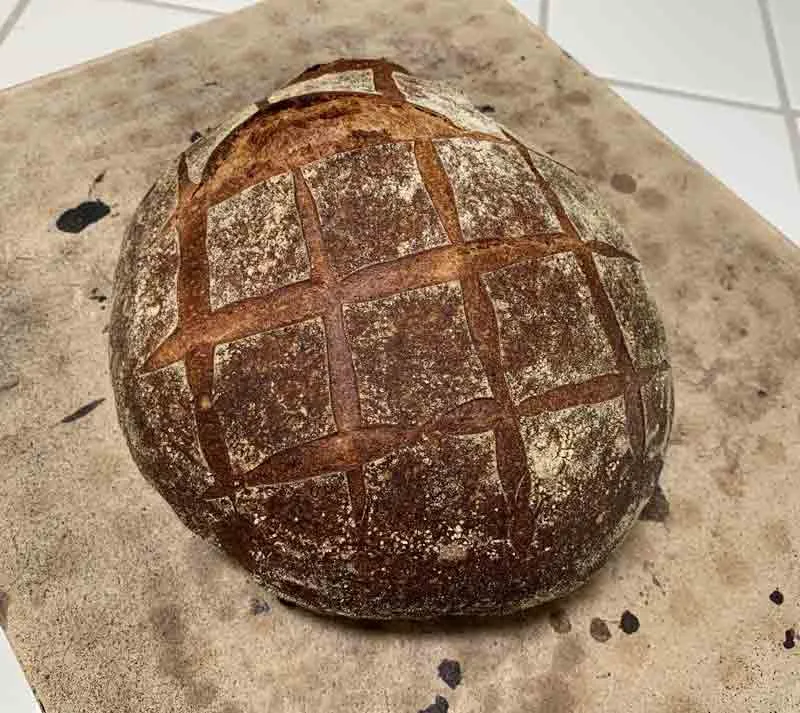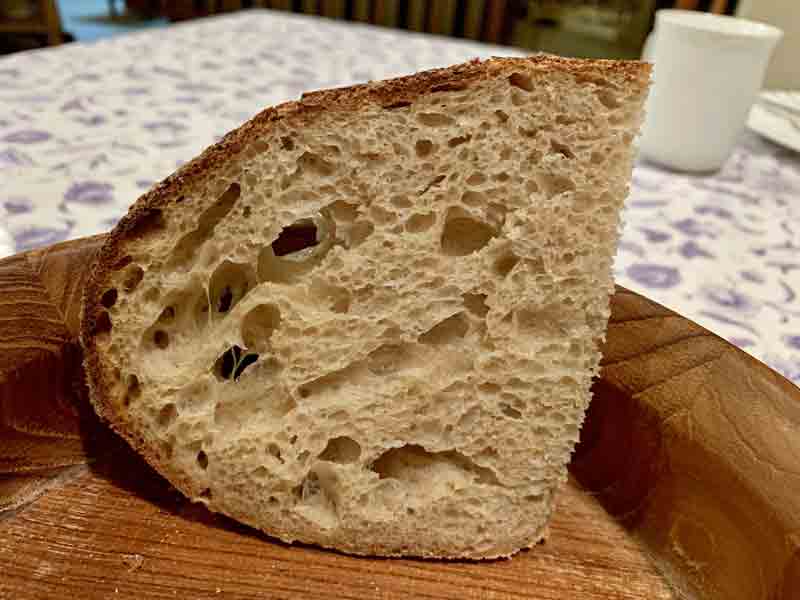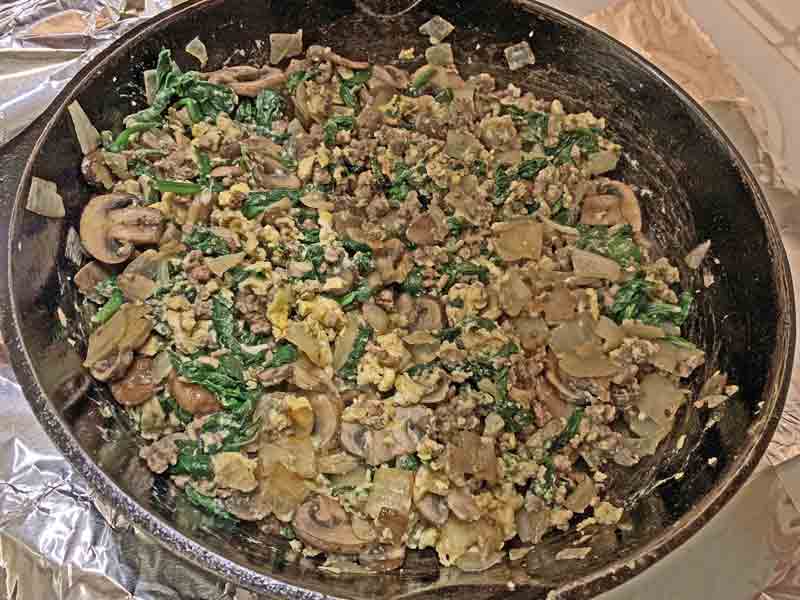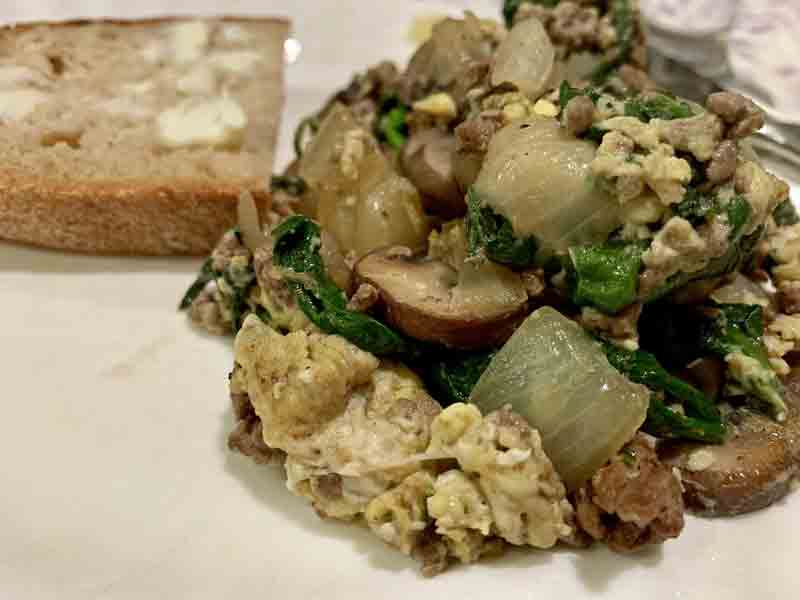
Mixed Grain Sourdough Bread
March, 2019
David M. Snyder
After the disappointing attempt to replicate Larraburu Brothers' San Francisco Sourdough Bread, I needed solace. The best cure for failure is to get up and do better.
I had recently had a nice message exchange with Dan Larsson, a very talented young Swedish baker. He posted photos on Instagram of a gorgeous loaf that was 20% fresh-milled Einkorn flour. In response to my questioning, Dan said Einkorn added a lot of good flavor and also speeded up fermentation. (It was not clear that was an Einkorn or just a whole grain flour effect.) Anyway, I decided to formulate a sourdough bread with 20% Einkorn just to see what I thought. I happened to have a bag or Einkorn berries, and I milled some fine Einkorn flour with my Mockmill100 for this test.
Total dough | Bakers' % | Wt (g) |
AP flour | 79 | 480 |
Whole rye flour | 2 | 11 |
Whole wheat (Einkorn) flour | 19 | 118 |
Salt | 2 | 12 |
Water | 75 | 457 |
Total | 177 | 1078 |
Note: I fed my starter with a flour mix consisting of 70% All Purpose flour, 20% Whole Wheat flour and 10% whole rye flour. I pre-mix these flours and keep them in a large, air-tight glass jar to use as needed. A typical pre-mix batch would be 280g AP + 80g WW + 40g Rye flours.
Note: For this bake, I used home-milled Einkorn flour for the “Whole Wheat flour” in the Final dough.
Starter1 | Bakers' % | Wt (g) |
Flour mix | 100 | 40 |
Water | 50 | 20 |
Stiff starter | 25 | 10 |
Total | 175 | 70 |
Dissolve the starter in the water. Add the flour blend and mix thoroughly until the flour has been completely incorporated and moistened.
Ferment at 76ºF for 6 hours
Starter 2 | Bakers' % | Wt (g) |
Flour mix | 100 | 100 |
Water | 50 | 50 |
Stiff starter | 20 | 20 |
Total | 170 | 170 |
Reserve 50 g of the ripe Starter 1 for another purpose.
Dissolve 20 g of the ripe Starter 1 in the water. Add the flour blend and mix thoroughly until the flour has been completely incorporated and moistened.
Ferment at room temperature for 5-6 hours.
Refrigerate overnight.
The next morning, let the starter come to room temperature during the autolyse.
Final dough | Wt (g) |
AP flour | 400 |
WW Flour | 95 |
Water (85ºF) | 401 |
Salt | 12 |
Stiff levain | 170 |
Total | 1078 |
Method
Mix the flour and water at low speed until they form a shaggy mass.
Cover and autolyse for 90 minutes
Add the salt and levain and mix thoroughly.
Form the dough into a ball and place the dough in a lightly oiled bowl and cover tightly.
Ferment at 76º F for 31/2 to 4 hours with a stretch and fold in the bowl at 30 minutes and 60 minutes and a stretch and fold on a lightly floured board at 90 minutes.
Divide the dough as desired or bake as one larger loaf.
Pre-shape as round(s) and rest, covered, for 10-30 minutes.
Shape each piece as a boule or bâtard and place in a banneton. Place banneton in plastic bags.
Proof at room temperature (68-70º F) for 1-2 hours. Do not over-proof. (My loaf was very puffy after 1 hour.)
Cold retard overnight.
The next morning, assess the degree of proofing. The loaf may be ready to bake or need additional proofing. Act accordingly.
45-60 minutes before baking, pre-heat the oven to 500º F with a baking stone and steaming apparatus in place.
Score as desired.
Bake at 460ºF with steam for 15 minutes, then for another 25-35 minutes in a dry oven.
(Optionally) Turn off the oven, and leave the loaves on the stone, with the oven door ajar, for another 15 minutes.
Transfer the bread to a cooling rack, and cool thoroughly before slicing.
I did not note that fermentation was any faster than usual, compared to other doughs with similar proportions of whole grain flour. I did note that the dough seemed less absorbent than usual, but then I have been baking breads that, most often, have at least double this proportion of whole grain flour.
On the other hand, there was amazing oven spring, and I don't think the loaf was under-proofed .... at least not by much.



The crust was crunchy, but becoming chewy. The crumb was tender-chewy. The flavor was wonderfully balanced with a prominent lactic acid mellow sour and just a touch of acetic acid tang. Lovely! We had some for dinner with Joe's Special.
For those not in the know, this is a very traditional San Francisco specialty invented by the long-closed New Joe's Restaurant, which was right on the Northeast corner of Broadway and Columbus in the heart of North Beach. It is a scramble of onions, ground beef, spinach and eggs. It might have garlic. I seasoned it with salt and pepper only. I added sautéd mushrooms. Some inauthentic versions add wine. Very delicious hot or cold.


Happy baking!
David
- dmsnyder's Blog
- Log in or register to post comments
I can’t wait to see the crumb.
larder and must try this formula...Stunning and must taste great too...
I noticed that you have used a stiff starter and stiff levain...I am intrigued and considering using a stiff starter especially for wholegrains...Why did you choose to use a stiff starter rather than a liquid one and I really would appreciate your thoughts on this. I have looked at BREAD and conversion between starters and I also noticed that liquid (125%) and stiffer starters are used for different breads but cannot find a detailed source to explain the thoughts behind this apart e.g. maintenance, more sour...and building strength in dough...
I was thinking of baking the same forumula with a stiff and liquid starter and to see whether there is a difference...
Kat
The one thing I know is that lower hydration starters are supposed to favor acetic acid production. But, interestingly enough, the formula for "San Francisco Sourdough" in Michel Suas' "Advanced Bread and Pastry" calls for a liquid starter. I do think there are other effect differences but I cannot recall them off the top of my head. As time allows, I may do a bit of research and update this.
If you do a comparison, please share your results! To get a true comparison, you need to make sure dough hydration is equalized.
David
to equalize water amount.when I do the experiment..there have been a number of interesting posts here on TFL about stiff starters too and I need to re-read ...
I just noticed recently a number of comments on IG where people appear to be using stiff starters particularly with freshly milled WWs or WWs in general and this made me wonder.....Kat
very useful post and answers most of my question..however to „feel“ the difference a bake with one liquid and one stiff sstarter would be interesting...will one have a better rise but not quite an open crumb based on the information? http://www.thefreshloaf.com/node/54900/functional-effect-biga-vs-poolish Such a delicate balance... Kat
I recently read Debra's post on LAB as recommended by my friend. If I grasp the concept correctly, it mentioned the effect of increasing hydration in two different aspects: total acid load and lactic acid to acetic acid ratio. Increasing hydration promotes bacterial activities generally and gives a higher rate of fermentation, no matter homofermentative, heterofermentative or facultative heterofermentative LAB are concerned. That's why usually higher hydration = sourer bread.
Moreover, heterofermentative LAB tend to break down the pentose sugar into ethanol + lactic acid, rather than acetic acid + lactic acid when fermentation is carried out at a higher rate. Facultative heterofermentative LAB also prefer to utilize hexose to produce energy so 2 lactic acid are generated, instead of acetic acid + lactic acid or ethanol + lactic acid when pentose is used. Supposedly, most acid produced would be lactic acid, giving a high lactic acid to acetic acid ratio.
Having said that, I've to confess that I've never had true "San Francisco SD". Therefore, I can't tell if it tastes more lactic or acetic :) I know you have quite a bit of knowledge in this area, David, so please correct me if I'm mistaken.
Now onto the bread, I know some people don't like the flavour of einkorn as they find it bitter. However, I find its taste pretty interesting: kind of sweet and coconut-ey. The crumb of your bread is amazing as always! The egg scramble looks nice too, even though I've never heard of the dish til now.
Thanks for your input!
The bacterial metabolism in sourdough is complex with a number of apparent paradoxes. These evidently do not bother the lactobacilli, who seem content to gobble sugar and poop out whatever works best for them at the moment. I, on the other hand, don't have a firm enough grasp on the myriad variables involved to feel totally in control of my LAB friends. I am confident that, if I find a particular set of ingredients, hydration and fermentation procedures that have a desirable effect, I can reproduce the effect, even if I cannot completely account for it.
The "true" San Francisco Sourdough was never one thing, because there were several bakeries, each different from the others in the bread they produced. In general though, the classic SF sourdough of my childhood was assertively sour, in an acetic acid way. However, it was better balanced, at least to me, than the bread Boudin is producing today, which I find silly sour. Again, the only place I know you can experience what it used to be like is at Tadich Grill. They serve a "secret" version baked for them by Boudin and available only in the restaurant. It is unreasonably delicious.
I did not get any bitterness at all from the bread with 20% Einkorn. Maybe it is at too low a percentage. I will have some more with dinner tonight and pay close attention to the flavor. Before then, I'm going to hit my books and see if I can shed any more light on the liquid vs. firm starter question.
David
The traditional New Joe's topping is a really nice touch as well . Crustini on steroids. Very nice in every way. Well done and happy baking David.
David
Hi David,
You have a lovely bake with einkorn. I have been dabbling with it for more than a year, first using Jovial flour (both whole and AP einkorn) and now milling my own. My observation is that einkorn does indeed ferment faster. I compared the whole grain einkorn flour to the AP and both were faster than other wheat flours, and the whole grain faster than the AP. Now, when I mill my own, I reduce the bulk fermentation time (assuming constant temperature) by as much as 25% to prevent overfermentation. I use 20% fresh milled einkorn as you did, and 20% fresh milled hard red wheat, the balance is a blend of AP and bread flour. I’ve pushed the hydration to 82%, but I think that is a little too high for this dough. 78% seems to work better to maintain the structure and fairly open crumb. The einkorn gives a moist crumb with nutty, almost sweet flavor.
I recently read somewhere that einkorn takes a longer time to hydrate than other wheats. I did not personally observe this, so I wonder if you had any thoughts on your experience.
Again, nice job.
-Brad
For sharing your experience.
This was my first use of einkorn, except for a pastry dough. I may follow your lead and try a 40% whole grain bread with einkorn and either red wheat or rye or some mix.
I believe I have read that einkorn absorbs water more slowly too. I think that's why I included a long autolyse.
Happy baking!
David